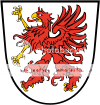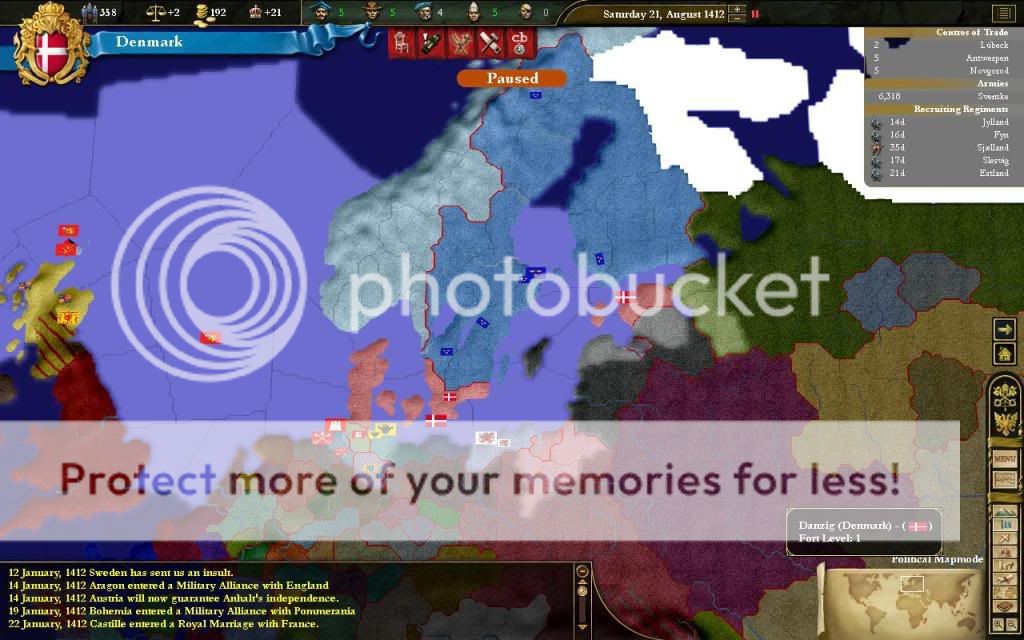Here it is, the war on the Order...
I must admid, that playing war seriously reduced my attention to the AAR. So, no screenshots and only a vague memory of the years between the battle of Ösel and January 1411.
Chapter III: The First Baltic War

The coat of arms of the house of Pomerania
As the Spring of 1406 began, the armies of Friedrich were still sieging Danzig and Visby. The fleet had anchored at the coast of Skåne, ready to transport 3000 men of the royal army to the island of Ösel.
Ösel, along with the rest of the Duchy of Estonia, had been mischievously occupied by the Teutonic Order durring the time when no king ruled in Denmark. As the poet would later write, “hvor ingen hegner, torne gro”- “where no-one puts up fences, thornes will grow”. Valdemar Atterdag had given up the duchy in exchange for gold, that he used to pay back the loans that his father had taken with the German counts. This meant, that in the eyes of the world, the Danish crown had no legitimate claims on the Duchy, even if it had been an integral part of the realm for more than a century.
However, this was of little concern to the Danish generals. They knew, that the Teutonic Order had a large army on the mainland. This army was restless, as it had no means of defending Gotland and Danzig. Ösel, however could be accessed from the mainland by a narrow strait. By laying siege to the island, the hope was to lure the army of the Order into an attack. Once they were on the island, the Danish fleet would move into the strait, effectively trapping them on Ösel while the combined armies of the Union conquered the mainland.
[Cheap trick, I know...]
The battle of Ösel was short with little bloodshed. The Danish army had spent days disbanding its camp in the central part of the island, ready to move across the strait to Kurland. The larger army of the Order arrived early in the morning, hoping to strike their enemy while asleep, but spies found 3000 men fully armed, with great pikes in the ground, aimed at stopping the onslaught of cavalry. The German generals held a short conference before deciding to take the cavalry around the small forrest that lay next to the camp, and attack from behind.
The Danes, however, had spies as well, and as soon as the dreaded cavalry were on their way around the forrest, the army quickly gathered their belongings and ran for the strait, meeting only little resistance from the bewildered men-at-arms that lay waiting for the sign to attack. The Danes jumped the ships that lay waiting by the beach, and were quickly taken across the strait, while the remainder of the fleet made sure that no other ships had access to the island. The Crusaders were trapped.
For four years, Danish ships lay around Ösel, while the army fought the remaining troops of the Order on the mainland. Kurland and Livland have a long history of strife, and many cities are well fortified, so the Danish troops were spread out thin. In December of 1410, however, Marienburg, the headquarters of the Order, was conquered. It was at this point, that the Swedish nobles finally sent their private troops to aid in the war. Within a year, all but the province of Memel had been conquered, and the Grand Master of the Order gladly gave away Estonia, Ösel and Danzig for peace, as well as the entire fortune of the Order.
Peace had come to the Union, but prosperity hadn’t. As it turned out, the befabled treasures of the Order had been utterly spent on mercenaries durring the war. All that was left for the Danish crown was a mere 25 ducats. The establishment of COT was still far away, but an important blow had been dealt to the Germans surrounding the Union, and the Duchy of Estonia was back on Danish hands.
Friedrich could now focus on gaining effective control of the realm. But the Swedish nobles would soon cause more problems.
The Union of Kalmar after the peace of Reval. New territories are Danzig, Estonia and Ösel.

I must admid, that playing war seriously reduced my attention to the AAR. So, no screenshots and only a vague memory of the years between the battle of Ösel and January 1411.
Chapter III: The First Baltic War

The coat of arms of the house of Pomerania
As the Spring of 1406 began, the armies of Friedrich were still sieging Danzig and Visby. The fleet had anchored at the coast of Skåne, ready to transport 3000 men of the royal army to the island of Ösel.
Ösel, along with the rest of the Duchy of Estonia, had been mischievously occupied by the Teutonic Order durring the time when no king ruled in Denmark. As the poet would later write, “hvor ingen hegner, torne gro”- “where no-one puts up fences, thornes will grow”. Valdemar Atterdag had given up the duchy in exchange for gold, that he used to pay back the loans that his father had taken with the German counts. This meant, that in the eyes of the world, the Danish crown had no legitimate claims on the Duchy, even if it had been an integral part of the realm for more than a century.
However, this was of little concern to the Danish generals. They knew, that the Teutonic Order had a large army on the mainland. This army was restless, as it had no means of defending Gotland and Danzig. Ösel, however could be accessed from the mainland by a narrow strait. By laying siege to the island, the hope was to lure the army of the Order into an attack. Once they were on the island, the Danish fleet would move into the strait, effectively trapping them on Ösel while the combined armies of the Union conquered the mainland.
[Cheap trick, I know...]
The battle of Ösel was short with little bloodshed. The Danish army had spent days disbanding its camp in the central part of the island, ready to move across the strait to Kurland. The larger army of the Order arrived early in the morning, hoping to strike their enemy while asleep, but spies found 3000 men fully armed, with great pikes in the ground, aimed at stopping the onslaught of cavalry. The German generals held a short conference before deciding to take the cavalry around the small forrest that lay next to the camp, and attack from behind.
The Danes, however, had spies as well, and as soon as the dreaded cavalry were on their way around the forrest, the army quickly gathered their belongings and ran for the strait, meeting only little resistance from the bewildered men-at-arms that lay waiting for the sign to attack. The Danes jumped the ships that lay waiting by the beach, and were quickly taken across the strait, while the remainder of the fleet made sure that no other ships had access to the island. The Crusaders were trapped.
For four years, Danish ships lay around Ösel, while the army fought the remaining troops of the Order on the mainland. Kurland and Livland have a long history of strife, and many cities are well fortified, so the Danish troops were spread out thin. In December of 1410, however, Marienburg, the headquarters of the Order, was conquered. It was at this point, that the Swedish nobles finally sent their private troops to aid in the war. Within a year, all but the province of Memel had been conquered, and the Grand Master of the Order gladly gave away Estonia, Ösel and Danzig for peace, as well as the entire fortune of the Order.
Peace had come to the Union, but prosperity hadn’t. As it turned out, the befabled treasures of the Order had been utterly spent on mercenaries durring the war. All that was left for the Danish crown was a mere 25 ducats. The establishment of COT was still far away, but an important blow had been dealt to the Germans surrounding the Union, and the Duchy of Estonia was back on Danish hands.
Friedrich could now focus on gaining effective control of the realm. But the Swedish nobles would soon cause more problems.
The Union of Kalmar after the peace of Reval. New territories are Danzig, Estonia and Ösel.

Last edited:






